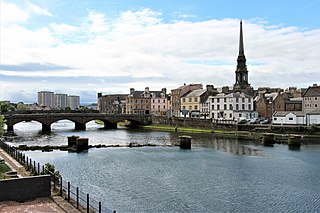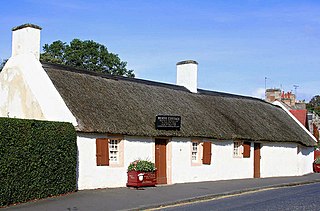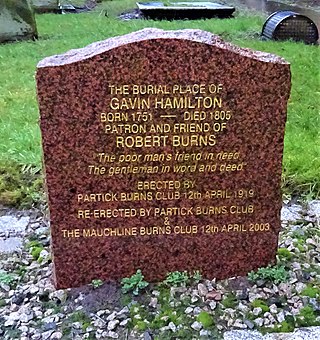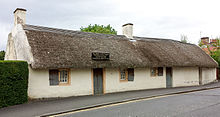
Ayr is a town situated on the southwest coast of Scotland. A former royal burgh, today it is the administrative centre of South Ayrshire Council, and the historic county town of Ayrshire. With a population of 46,982, Ayr is the 15th largest settlement in Scotland and second largest town in Ayrshire by population. The town is contiguous with the smaller town of Prestwick to the north. Ayr submitted unsuccessful bids for city status in 2000 and 2002, and as part of the wider South Ayrshire area in 2022.

Kyle and Carrick was one of nineteen local government districts in the Strathclyde region of Scotland from 1975 to 1996.

Stair is a parish in Ayrshire, Scotland. It lies at the bottom of a glen beside the River Ayr at the north-west border of the 5,376 acre (22 km2) Parish of Stair where the River Ayr is joined by the Glenstang Burn.

Ayr, Carrick and Cumnock is a county constituency represented in the House of Commons of the Parliament of the United Kingdom. It was created for the 2005 general election from parts of the old Ayr and Carrick, Cumnock and Doon Valley constituencies. It has been represented since 2024 by Elaine Stewart of Scottish Labour.

The Alloway Auld Kirk, which dates back to the 16th century, is a ruin in Alloway, South Ayrshire, Scotland, celebrated as the scene of the witches' dance in the poem "Tam o' Shanter" by Robert Burns.

The River Doon is a river in Ayrshire, Scotland. Its course is generally north-westerly, passing near to the town of Dalmellington, and through the villages of Patna, Dalrymple, and Alloway, birthplace of Robert Burns. The source of the Doon is Loch Doon, high in the Galloway Hills.

"Tam o' Shanter" is a narrative poem written by the Scottish poet Robert Burns in 1790, while living in Dumfries. First published in 1791, at 228 lines it is one of Burns' longer poems, and employs a mixture of Scots and English.
Glenbuck is a small, remote village in East Ayrshire. It is nestled in the hills 3 miles (5 km) east of Muirkirk, East Ayrshire, Scotland.
Doonfoot is a suburb in the south-west of Ayr, South Ayrshire.

James Main Dixon FRSE was a Scottish teacher and author, and an important scholar of the Scots language.

Burns Cottage is the birthplace of Robert Burns, Scotland's national poet, who was born at the cottage on 25 January 1759. It is located in Alloway, a current suburb of Ayr, and a former village, located in South Ayrshire, Scotland. The cottage was built by Robert Burns' father, William Burnes in 1757 and is a four-roomed clay and thatch cottage which has been fully restored to become part of the Robert Burns Birthplace Museum.

The Brig o' Doon, sometimes called the Auld Brig or Old Bridge of Doon, is a late medieval bridge in Ayrshire, Scotland, and a Category A structure.

Robert Burns, also known familiarly as Rabbie Burns, was a Scottish poet and lyricist. He is widely regarded as the national poet of Scotland and is celebrated worldwide. He is the best known of the poets who have written in the Scots language, although much of his writing is in a "light Scots dialect" of English, accessible to an audience beyond Scotland. He also wrote in standard English, and in these writings his political or civil commentary is often at its bluntest.

Coylton is a village and civil parish in South Ayrshire, Scotland. It is five miles east of Ayr and 2+1⁄2 miles west of Drongan, on the A70. Sundrum Castle Holiday Park is to the west of the village, in the grounds of Sundrum Castle, which partly dates to the 13th century. A rocking stone stands atop the Craigs of Kyle near Coylton. It weighs about 30 tons and rests upon two stones. A large standing stone known as Wallace's Stone stands nearby. The village is also home to a parish church of the Gothic style, built in 1832.

James Smith of Monkwood Grove was a Scottish botanist and nurseryman. He founded the Monkwood Botanic Garden in Maybole Parish which included several thousand species of exotic and native British plants. A regular consultant of his English contemporaries, he is credited with the discovery of Primula scotica,Salix caprea pendula and several other species of plants native to Scotland. Owing to this particular interest in the flora of Scotland, Smith has been described as the "father of Scottish botany."

Minishant is a village bordering the A77 in the old county of Carrick, South Ayrshire, Scotland. It is located in Maybole Parish, 3+1⁄2 miles from Maybole and standing close to the River Doon. The village was originally named Culroy after the Culroy Burn that runs through it.

Gavin Hamilton was one of Robert Burns's closest friends and a patron. The first 'Kilmarnock Edition' of his poems were dedicated to Gavin Hamilton.

John Ballantine (1743–1812), was a Scottish merchant and banker and one of the greatest friends, admirers and closest confidants of Robert Burns. Significantly Ballantine gave the poet advice on the selection of poems for his First Kilmarnock Edition as well as being asked for his opinion on the bard's poems.
Hamilton Paul was a Scottish church minister, and a writer, poet and humourist. In 1819 he edited the works of Robert Burns.




















